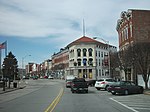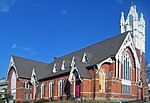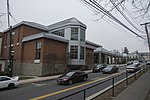Ossining High School
1930 establishments in New York (state)Historic district contributing properties in New York (state)NRHP infobox with nocatNational Register of Historic Places in Westchester County, New YorkOssining, New York ... and 3 more
Public high schools in Westchester County, New YorkSchool buildings completed in 1930School buildings on the National Register of Historic Places in New York (state)

Ossining High School (OHS) is a comprehensive public high school located in Ossining, New York, United States, along the Hudson River in northern Westchester County, New York. Serving grades 9 through 12, it is the sole high school within the Ossining Union Free School District. The school serves the entirety of the village of Ossining, portions of the Village of Briarcliff Manor, Town of Ossining, and Town of New Castle, as well as a very small southern portion of the Town of Yorktown.Its building is a historical contributing property within the Downtown Ossining Historic District, which was added to the U.S. National Register of Historic Places in 1989.
Excerpt from the Wikipedia article Ossining High School (License: CC BY-SA 3.0, Authors, Images).Ossining High School
South Highland Avenue,
Geographical coordinates (GPS) Address Nearby Places Show on map
Geographical coordinates (GPS)
| Latitude | Longitude |
|---|---|
| N 41.1602 ° | E -73.86 ° |
Address
WOSS-FM (Ossining)
South Highland Avenue
10562
New York, United States
Open on Google Maps








